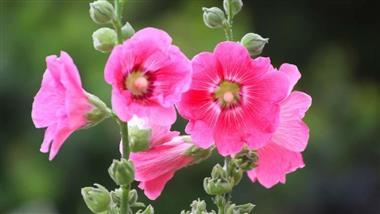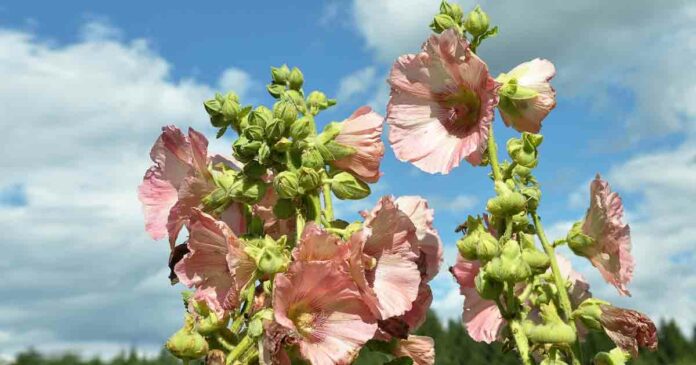Help Ease Inflammation With Hollyhock

Story at-a-glance
- If you have hollyhock plants growing in your garden or backyard, you’re in luck, because you can use them to help ease a few common conditions naturally and safely
- Did you know hollyhock can be used to ease inflammation and improve digestion? Learn more about this beautiful herb and how you can benefit from it
Hollyhock, or Alcea rosea, is an herb known for its vibrant and attention-grabbing flowers, with colors ranging from light pink to dark purple. Aside from its beautiful blooms, hollyhock is also well-known for its medicinal purposes. If you have hollyhock plants growing in your garden or backyard, you’re in luck, because you can use them to help ease a few common conditions naturally and safely. Continue reading to learn more about this plant and how it can help improve your health.
What Is Hollyhock?
The term “hollyhock” is generally used as a collective term for the genus Alcea, which consists of approximately 60 flowering varieties.1 This article will focus on Alcea rosea, which is the most common species of all the Alcea plants.2
Hollyhock was originally from China, where it was eaten as a potherb. It is typically abundant in Europe and Asia, but also thrives in the U.S. and other regions due to its hardy nature. One of the possible reasons this plant is called hollyhock is because the first plants sent to Southern Europe came from the Holy Land.
In earlier times, hollyhock was especially popular among the Spanish, who thought it to be the perfect reflection of God’s love because the plant was extremely enduring.3 Over the years, however, its popularity as a garden plant has waned due to its susceptibility to multiple diseases and pests, especially a fungus gardeners call “rust.”
Rust, or Puccinia malvacearum, usually grows on hollyhock leaves and can cause them to become severely disfigured. While hollyhock rust may cause you to have second thoughts about planting your own hollyhock herbs, there are ways to prevent it from infecting your beloved plants.4
What Are the Health Benefits of Hollyhock?
Hollyhock may be a beautiful addition to anyone’s garden or yard, but its benefits transcend the exquisiteness of its flowers. Aside from its gardening uses, hollyhock is incredibly useful when it comes to your health. Some of the benefits it has are:
• May help ease digestive problems — Throughout history, hollyhock has been lauded for its positive effect on the digestive system. An 1859 medical book notes that hollyhock blossoms were mixed with poplar bark, bayberry, goldenseal and other herbs to promote digestion and “warm the stomach and bowels.”5
• Soothes cold symptoms — Hollyhock was brewed as tea to calm respiratory ailments. Arabians and Costa Ricans were noted to drink sweetened hollyhock tea to ease coughs and sore throat.6
• May relieve inflammation — Brazilians and Chileans use hollyhock leaves as a poultice to alleviate inflammation and tumors. Hollyhock seeds may also be crushed and applied topically to treat abscesses.7
3 Uses of Hollyhock
Aside from being an ornamental plant, you can use hollyhock as a:
• Natural cotton or fabric dye — Hollyhocks have been used to dye cotton for over 200 years. In fact, the oldest documentation of dyeing using hollyhock flowers dates back to the 19th century. Germans first started using hollyhock to add color to wine, but later began using it on fabric as well. Hollyhock flowers in lighter shades produce a yellow to a golden brown hue, while the darker variants produce shades that can be as light as lilac or as dark as deep mauve.8
• Recipe ingredient — Young hollyhock leaves, flowers and the inner portion of hollyhock stems may be eaten raw or added to salads.9
• Tea — Hollyhock flowers and buds may be brewed into a tea for a refreshing beverage.10
Here’s How You Can Grow Hollyhocks
Growing your own hollyhock plants is relatively easy, as long as you make sure they get enough sunlight and moisture. These plants can reach a whopping 9 feet tall, which makes them suitable for growing near walls or fences. They are also especially appealing to both butterflies and hummingbirds. To grow your own hollyhocks, follow this step-by-step guide:11,12
Directions
1. Find a suitable location that is exposed to either full sun or partial shade.
2. Prepare the soil by working compost or aged animal manure into it. This will improve the soil’s ability to hold nutrients and moisture.
3. Sow hollyhock seeds one to two weeks after the last frost. Plant them no more than 1/4 inch deep and maintain spacing of 2 feet between plants.
4. The seeds will germinate within 10 to 14 days. Water the plants regularly.
Note that hollyhocks are very vulnerable to certain pests and fungal diseases, including beetles, sawflies, powdery mildew and rust, with rust being the most damaging. Below are two tips on how to significantly lower your plants’ susceptibility to rust:13
• Employ soaker hoses or drip irrigation. Avoid using overhead watering to limit the moisture on the aerial portion of your hollyhocks.
• Maintain proper space between your plants to promote better air circulation. As mentioned, give them at least 2 feet of breathing space.
Try This Spring Salad Recipe With Hollyhock Flowers
Hollyhock flowers are edible, which makes them ideal additions to salads and side dishes. Hollyhocks are just one of 42 flowers you can eat. Below is a spring salad recipe featuring hollyhocks:14
Spring Salad With Edible Flowers
Ingredients
• 5 ounces baby spring greens
• 1 small sweet onion
• Hollyhock and other edible flowers like geraniums and marigolds
• 1/4 cup dressing of your choice
Procedure
1. Peel and slice onion into paper-thin slices.
2. Put the dressing at the bottom of a large salad bowl.
3. Add the greens and onions to the bowl.
4. Scatter the edible flowers on the top of the greens.
5. Toss the salad just prior to serving.
Here’s How You Can Correctly Harvest and Store Hollyhock Seeds
Hollyhocks are usually categorized as either a perennial or a biennial, with plants only living up to three years. Most hollyhock plants are biennial, but this largely depends on plant care. If you’d like to keep hollyhocks growing in your garden, it might be a good idea to save your hollyhock seeds. Here’s how you can collect the seeds and prepare them for storage:15
How to Store Hollyhock
1. Wait for the flowers to wilt into large brown pods.
2. Snap them off the plant and drop them into a paper bag. Let them sit in the paper bag for a few days to dry out further.
3. After a few days, remove the pods from the bag and break them apart onto paper towels.
4. Break apart the clumps of seeds inside the pods. Remove the chaff from the individual seeds to limit moisture.
5. Arrange the seeds on top of the paper towel and leave them to dry for a few days.
6. Once dry, place the seeds inside an airtight glass container. Store in a cool place, such as your refrigerator or a freezer.
Hollyhock: A Beautiful and Useful Addition to Your Garden
If you grew up with hollyhocks, you probably remember these colorful flowers with fondness. While their vibrant colors may have lifted your mood on gloomy days, you now know they are edible and can boost your health. You might try them to alleviate inflammation and support healthy digestion. Hollyhocks might not be as popular as they once were, but it’s never too late for them to make a comeback.
Frequently Asked Questions (FAQs) About Hollyhock
Q: Are hollyhocks perennials?
A: The categorization of hollyhocks is more complicated than other plants. Some sources claim hollyhocks are biennial because they bloom in their second year, but another source says hollyhocks are short-lived perennials. The correct categorization, however, is that they are biennial, but their ability to return in future years depends largely on how the plants are cared for, as well as when and where they are planted.16
Q: Are hollyhocks poisonous?
A: Hollyhocks are not poisonous to humans or animals, so you shouldn’t be alarmed if your dog accidentally tears your hollyhocks apart and eats some of the flowers.17
Q: Do hollyhocks bloom all summer?
A: While hollyhock flowers last only a few days before wilting, this plant’s blooming season may last from three weeks to three months during the summer.18
Q: Can you grow hollyhocks in a pot?
A: Hollyhocks may be grown in pots or containers, as long as they get enough sunlight and nutrients. Be sure to use a large pot because hollyhocks need a lot of room to grow.19
Sources and References
- 1 Flora of China Vol. 12 Pages 265, 267
- 2 Garden Lovers Club, The Different Varieties of Hollyhocks
- 3 Los Jardineros, Garden Club of Taos
- 4 Royal Horticultural Society, Hollyhock rust
- 5 John W. Comfort, The Practice of Medicine on Thomsonian Principles
- 6, 7 James Duke, Duke’s Handbook of Medicinal Plants of the Bible
- 8 Laurie Pippen, Laurie Pippen’s All Natural Colorants for Cosmetic, Culinary and Textile Dyeing
- 9, 10 T.K. Lim, Edible Medicinal and Non Medicinal Plants: Volume 8, Flowers
- 11, 13 Planet Natural Research Center, Hollyhock
- 12 Gardening Know How, Tips on Hollyhocks: Growing Hollyhocks Successfully
- 14 The View from Great Island, Spring Salad with Edible Flowers
- 15 DenGarden, How to Grow Hollyhock From Seed
- 16, 18 Hunker, Is a Hollyhock an Annual or a Perennial?
- 17 SFGate, Are Hollyhocks Poisonous to Dogs?
- 19 SF Gate, Growing Hollyhocks in a Container

